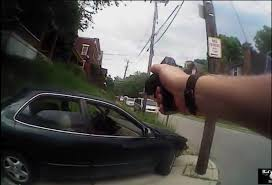
Hamilton County Common Pleas Court Judge Leslie Ghiz today ruled to allow testimony from defense witness Scott Roder in the retrial of former University of Cincinnati police officer Ray Tensing. Roder says he has worked as an expert doing forensic animation on more than 500 cases. But a federal judge last year faulted Roder for opining on areas outside his expertise.
Tensing’s defense, led by attorney Stew Mathews, hired Roder as an expert witness in Tensing’s murder and manslaughter retrial for the shooting death of unarmed black motorist Sam DuBose during a traffic stop in Mount Auburn in July 2015. A previous trial ended in a hung jury in November last year.
Ghiz ruled today that Roder’s testimony as a video analyst expert would be allowed in the trial, though Roder admitted he is not certified specifically as a video analyst.Roder says he's unbiased and scientific and has worked with video for years, taking a "common sense" approach to such evidence.
Ghiz also allowed prosecution video expert Grant Fredericks to again appear as an expert after his credentials were reviewed in court.
Tensing said he feared for his life when he shot DuBose. He initially claimed he was dragged by DuBose’s car, though footage from the officer’s body camera showed that did not happen.
Roder will be allowed to testify that, according to his analysis, Tensing felt justifiable fear for his life when he drew his gun and shot DuBose once in the head within a second of DuBose’s car lurching forward. But animations of the shooting Roder made for the defense are off-limits.
“Any animation that he has done is not being admitted,” Ghiz said. “The best evidence is the video itself. He can be considered and can be used if the defense so chooses as a video analyst expert.”
Roder is the founder of The Evidence Room, an Independence, Ohio-based forensic animation company. In court, Roder said he has testified in over 500 cases over the course of 24 years, including 50 officer-involved shooting cases.
But in at least one of those cases, Roder presented his opinions as facts, according to the federal judge.
In a March 2016 ruling about a case involving a police-involved shooting in Columbus, Roder testified for plaintiffs claiming excessive use of force by an officer who shot an armed man.
In a ruling siding with the defense, U.S. District Court Judge Gregory Frost cited Roder’s “proclivity for offering opinions” and noted multiple times when Roder offered speculation as fact on issues where he was not qualified to offer expert opinion.
“Roder explained at his deposition that he has been previously qualified as an expert in forensic animation, although he explained he is not a forensic scientist,” wrote Frost, who presides over the Southern District of Ohio Eastern Division. “He testified that he was not offering an expert opinion in this case, but that he was ‘demonstrating the physical evidence through [a] 3D computer-generated crime scene.’ Roder then proceeded, essentially, to offer an opinion on the central issue in this case…”
Frost later faults Roder for offering “assumptions conflated with data, all of which he is interpreting,” and of “not being an expert capable of asserting several of the opinions he offers.”
Prosecutors grilled Roder during today’s hearing, and were not pleased his testimony will be admitted as evidence.
“He has no scientific basis to say anything he’s said,” Hamilton County Prosecutor Seth Tieger said during the proceedings.
This won’t be Roder’s first high-profile case. His company, The Evidence Room, was involved in a controversy around the Oscar Pistorius trial in South Africa. Pistorius, a famous para-olympian, was on trial for shooting his girlfriend when his uncle hired The Evidence Room in 2013 to produce an animation of the incident that looked to prove that the shooting was an accident.
That animation wasn’t used as evidence in the case, but it did end up airing on an Australian cable news network during the trial — something Pistorius’ lawyers said was illegal and threatened a lawsuit over. Roder also provided commentary to Channel 7, the broadcaster that aired the video. Channel 7 says the video was obtained and aired legally in Australia.

